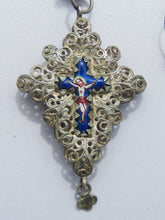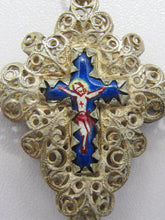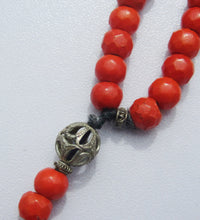
Bavarian Coral Rosary, Antique Silver And Coral 'Beidermeier' Rosary, Stunning Condition, 5 Decade, 48 cm Long, Circa 1840
A truly beautiful rosary made in the Bavarian region of Germany in the 'Beidermeier' period between 1815 and 1848.
The rosary has a total length of 48 cm. Each of the exquisite silver filigree Paternoster links is a full 1 cm in diameter while the reliquary cross is 6.5 x 3 x 1.3 cm.
Centred in this cross is a lovely porcelain cross and it is very rare to find these with no chips or cracks but this one is perfect on both sides.
The little cross that comes before the bigger one on the filigree rosary is called the Credo Cross. It is on the open part of the rosary. It comes after the 3 Ave beads embedded in two holy Father beads and before the Large cross at the end. It comes from the Kounzil of Trient (1545-63). It is a sign to remember: Belief - Hope - Charity. The Credo Cross was given up during the 19th century.
These gorgeous rosaries have been handed down in families for many generations and rarely come up for sale. That, and the exquisite workmanship required to create them, is one of the reasons why they sell for such huge prices. In fact there are other examples on Etsy all of which sell for sums from 450 - 750 euros and elsewhere they sell for much, much more.
I am very fortunate that my daughters live in Germany and share my passion for beautiful Christian items and they have been collecting some fabulous things for me to bring to you and as they come from the source I can offer them at much more reasonable prices.
What is a 'Beidermeier' rosary.
By the end of the Napoleonic wars Europe had been in turmoil for decades and the population yearned for a period of peace and stability. The 'Beidermeier' period stretches from the Congress of Vienna in 1815 to the bourgeois revolution of 1848 but it was not called that until 1855.
The problem during that period for the people was that in order to impose order and stability the German princes resorted to measures of oppression including prohibition of fraternities, extensive censorship, control of universities, etc. However, for the prospect of stable conditions, a large part of the population was willing to give up political and intellectual freedoms.
The term 'Beidermeier' came from a series of satirical articles published in the 1850s in Munich. Although Biedermeier is initially meant to be caricaturing, it held up bourgeois virtues such as hard work, honesty, order, as well as sense of duty and modesty all of which are deeply held traits of the German people.
In the harsh era in which they were living people turned to the comforts of family, friends and spirituality.
It was a reaction to the austere times that these sumptuous and ornate rosaries were produced in the southern part of Germany and that is why they are referred to as Beidermeier Rosaries.













